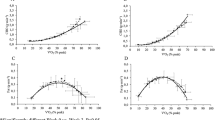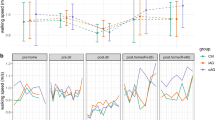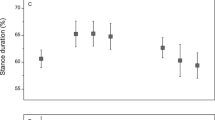Abstract
Aim
Weight loss leads to a reduction of the energy cost of walking but the respective implications of the metabolic and mechanic changes remain unknown. The present study compares the post-weight loss energy cost of walking (Cw) with and without a total reload of the induced weight reduction in adolescents with obesity.
Methods
Energy cost of walking and substrate use were evaluated during a graded walking exercise (4×6-min at 0.75, 1, 1.25, 1.5 m.s−1) before (V1) and after a 12-week intervention in 21 adolescents with obesity (11 girls; 13.8 ± 1.4 y). After weight loss, the walking exercise was randomly repeated once without weight reload (V2) and once with a loading corresponding to the total induced weight loss during the program (V2L). Body composition was assessed before and after the intervention.
Results
Body weight and fat mass decreased in response to the 12-week intervention (p < 0.001), while FFM did not change. The absolute gross Cw (ml.m−1) was higher on V1 compared with V2 at every speed. The absolute net Cw (ml.m−1) was higher on V1 compared to V2L at 0.75 m.s−1 (p = 0.04) and 1 m.s−1 (p = 0.02) and higher on V2L compared with V2 at 1.5 m.s−1 (p = 0.03). Net Cw (ml.m−1.kg−1) on V1 being higher than V2 (p < 0.001), and V2L higher than V2 (p = 0.006). The absolute CHO oxidation (mg.min−1) did not show any condition effect (p = 0.12) while fat utilization was higher on V1 compared to V2 and V2L (p < 0.001). Relative to body weight CHO oxidation was lower on V1 compared to V2 (p = 0.04) and V2L (p = 0.004) while relative to body weight fat oxidation was higher on V1 than V2 (p = 0.002).
Conclusion
Adolescents with obesity might not show an entire rise back to pre-weight loss values of their metabolic cost of walking when weight gain is simulated. These new findings suggest metabolic and physiological adaptations to weight loss of the energy metabolism that remain to be clarified.
This is a preview of subscription content, access via your institution
Access options
Subscribe to this journal
Receive 12 print issues and online access
$259.00 per year
only $21.58 per issue
Buy this article
- Purchase on Springer Link
- Instant access to full article PDF
Prices may be subject to local taxes which are calculated during checkout

Similar content being viewed by others
Data availability
The datasets generated during and/or analyzed during the current study are available from the corresponding author on reasonable request.
References
Vanhelst J, Baudelet JB, Thivel D, Ovigneur H, Deschamps T. Trends in the prevalence of overweight, obesity and underweight in French children, aged 4-12 years, from 2013 to 2017. Public Health Nutr. 2020;27:1–7.
Ferreira YAM, Kravchychyn ACP, Vicente SCF, Campos RMDS, Tock L, Oyama LM, et al. An interdisciplinary weight loss program improves body composition and metabolic profile in adolescents with obesity: associations with the dietary inflammatory index. Front Nutr. 2019;6:77.
Khammassi M, Miguet M, O’Malley G, Fillon A, Masurier J, Damaso AR, et al. Health-related quality of life and perceived health status of adolescents with obesity are improved by a 10-month multidisciplinary intervention. Physiol Behav. 2019;210:112549.
Hoedjes M, Makkes S, Halberstadt J, Noordam H, Renders CM, Bosmans JE, et al. Health-related quality of life in children and adolescents with severe obesity after intensive lifestyle treatment and at 1-year follow-up. Obes Facts. 2018;11:116–28.
Miguet M, Fearnbach NS, Metz L, Khammassi M, Julian V, Cardenoux C, et al. Effect of HIIT versus MICT on body composition and energy intake in dietary restrained and unrestrained adolescents with obesity. Appl Physiol Nutr Metab. 2020;45:437–45.
Miguet M, Masurier J, Chaput JP, Pereira B, Lambert C, Dâmaso AR, et al. Cognitive restriction accentuates the increased energy intake response to a 10-month multidisciplinary weight loss program in adolescents with obesity. Appetite. 2019;134:125–34.
Lazzer S, Boirie Y, Montaurier C, Vernet J, Meyer M, Vermorel M, et al. A weight reduction program preserves fat-free mass but not metabolic rate in obese adolescents. Obes Res. 2004;12:233–40.
Peyrot N, Thivel D, Isacco L, Morin JB, Duché P, Belli A. Do mechanical gait parameters explain the higher metabolic cost of walking in obese adolescents? J Appl Physiol. 2009;106:1763–70.
Peyrot N, Morin JB, Thivel D, Isacco L, Taillardat M, Belli M, et al. Mechanical work and metabolic cost of walking after weight loss in obese adolescents. Med Sci Sports Exerc. 2010;42:1914–22.
Peyrot N, Thivel D, Isacco L, Morin JB, Belli A, Duché P. Why does walking economy improve after weight loss in obese adolescents? Med Sci Sports Exerc. 2012;44:659–65.
D’Alleva M, Gonnelli F, Vaccari F, Boirie Y, Montaurier C, Thivel D, et al. Energy cost of walking and body composition changes during a 9-month multidisciplinary weight reduction program and 4-month follow-up in adolescents with obesity. Appl Physiol Nutr Metab. 2021;13:1–9.
Ohlsson C, Gidestrand E, Bellman J, Larsson C, Palsdottir V, Hägg D, et al. Increased weight loading reduces body weight and body fat in obese subjects - a proof of concept randomized clinical trial. EClinicalMedicine. 2020;22:100338.
Thivel D, Boirie Y. The Gravitostat theory: Body fat is lost but is fat-free mass preserved? EClinicalMedicine. 2020;27:100531.
Jansson JO, Anesten F, Hägg D, Zlatkovic J, Dickson SL, JanssonPA, et al. The dual hypothesis of homeostatic body weight regulation, including gravity-dependent and leptin-dependent actions. Philos Trans R Soc Lond B Biol Sci. 2023;378:20220219.
Bake T, Peris-Sampedro F, Wáczek Z, Ohlsson C, Pálsdóttir V, Jansson JO, et al. The gravitostat protects diet-induced obese rats against fat accumulation and weight gain. Neuroendocrinol. 2021;33:e12997.
Isacco L, Lambert C, Siroux J, Boscaro A, Cardenoux C, Julian V. et al. Weight loss does not affect the sit-to-stand metabolic cost in adolescents with obesity. Eur J Appl Physiol. 2023;123:2511–2523.
Peronnet F, Massicotte D. Table of nonprotein respiratory quotient: an update. Can J Sport Sci. 1991;16:23–29.
Williams G, Eston R, Furlong B. CERT: a perceived exertion scale for young children. Percept. Mot. Skills. 1994;79:1451–8.
Feise RJ. Do multiple outcome measures require p-value adjustment? BMC Med. Res. Methodol. 2002;2:8.
Oliveira HB, da Rosa RG, Gomeñuka NA, Carvalho AR, Costa RFD, Peyré-Tartaruga LA. When mechanical work meets energetics: obese versus non-obese children walking. Exp Physiol. 2020;105:1124–31.
Alemayehu HK, Salvadego D, Isola M, Tringali G, De Micheli R, Caccavale M, et al. Three weeks of respiratory muscle endurance training improve the O2 cost of walking and exercise tolerance in obese adolescents. Physiol Rep. 2018;6:e13888.
Ben Ounis O, Elloumi M, Zouhal H, Makni E, Lac G, Tbka Z, et al. Effect of an individualized physical training program on resting cortisol and growth hormone levels and fat oxidation during exercise in obese children. Ann Endocrinol. 2011;72:34–41.
Lazzer S, Vermorel M, Montaurier C, Meyer M, Boirie Y. Changes in adipocyte hormones and lipid oxidation associated with weight loss and regain in severely obese adolescents. Int J Obes. 2005;29:1184–91.
Nitsche H, Nitsche M, Sudi K, Tschop M, Zotter H, Weinhand G, et al. Ghrelin-an indicator for fat oxidation in obese children and adolescents during a weight reduction program. Pediatr Endocrinol Metab. 2007;20:719–23.
van der Heijden GJ, Sauer PJ, Sunehag AL. Twelve weeks of moderate aerobic exercise without dietary intervention or weight loss does not affect 24-h energy expenditure in lean and obese adolescents. Am J Clin Nutr. 2010;91:589–96.
Lazzer S, Lafortuna C, Busti C, Galli R, Agosti F, Sartorio A. Effects of low- and high-intensity exercise training on body composition and substrate metabolism in obese adolescents. J Endocrinol Invest. 2011;34:45–52.
an Aggel-Leijssen DP, Saris WH, Hul GB, van Baak MA. Short-term effects of weight loss with or without low-intensity exercise training on fat metabolism in obese men. Am J Clin Nutr. 2001;73:523–31.
Thivel D, Metz L, Julian V, Isacco L, Verney J, Ennequin G, et al. Diet- but not exercise-induced iso-energetic deficit induces compensatory appetitive responses. Eur J Clin Nutr. 2021;75:1425–32.
Vermorel M, Lazzer S, Bitar A, Ribeyre J, Montaurier C, Fellmann N, et al. Contributing factors and variability of energy expenditure in non-obese, obese, and post-obese adolescents. Reprod Nutr Dev. 2005;45:129–42.
Shuhada NA, Ong MLY, Chen CK. The effects of walking with a load in the heat on physiological responses among military reserve female cadets. Int J Exerc Sci. 2020;13:900–11.
Datta SR, Chatterjee BB, Roy BN. The relationship between energy expenditure and pulse rates with body weight and the load carried during load carrying on the level. Ergonomics. 1973;25:35–41.
Silder A, Delp SL, Besier T. Men and women adopt similar walking mechanics and muscle activation patterns during load carriage. J Biomech. 2013;46:2522–8.
Ludlow LW, Weyand PGJ. Walking economy is predictably determined by speed, grade, and gravitational load. Appl Physiol. 2017;123:1288–302.
Grabowski A, Farley CT, Kram R. Independent metabolic costs ofsupporting body weight and accelerating body mass during walking. JAppl Physiol. 2005;98:579–83.
Grenier JG, Peyrot N, Castells J, Oullion R, Messonnier L, Morin JB. Energy cost and mechanical work of walking during load carriage insoldiers. Med Sci Sports Exerc. 2012;44:1131–40.
Huang TW, Kuo AD. Mechanics and energetics of load carriage during human walking. J Exp Biol. 2014;217:605–13.
Browning RC, Reynolds MM, Board WJ, Walters KA, Reiser RF. 2nd. Obesity does not impair walking economy across a range of speeds and grades. J Appl Physiol. 2013;114:1125–31.
Acknowledgements
The authors want to thank the adolescents who took part in the study and their educators. We also thank the French National University Institute (IUF).
Author information
Authors and Affiliations
Contributions
TD, EG, IL, DL and YB conceptualized the study and handled the ethical and administrative processes. YB, MD, VJ, CC performed the medical inclusion and led the medical supervision of the intervention. LI, GE, JS, AB, PL performed the data collection and management. TD, LI, BP, CL performed the statistical analysis. TD, EG, LI, SL, SR interpreted the results and wrote the first draft of the paper. All authors have read and approved the final version of the manuscript, and agree with the order of presentation of the authors.
Corresponding author
Ethics declarations
Competing interests
The authors declare no competing interests.
Additional information
Publisher’s note Springer Nature remains neutral with regard to jurisdictional claims in published maps and institutional affiliations.
Supplementary information
Rights and permissions
Springer Nature or its licensor (e.g. a society or other partner) holds exclusive rights to this article under a publishing agreement with the author(s) or other rightsholder(s); author self-archiving of the accepted manuscript version of this article is solely governed by the terms of such publishing agreement and applicable law.
About this article
Cite this article
Thivel, D., Ennequin, G., Lambert, C. et al. Improved walking energy efficiency might persist in presence of simulated full weight regain after multidisciplinary weight loss in adolescents with obesity: the POWELL study. Int J Obes 48, 384–393 (2024). https://doi.org/10.1038/s41366-023-01427-w
Received:
Revised:
Accepted:
Published:
Issue Date:
DOI: https://doi.org/10.1038/s41366-023-01427-w



